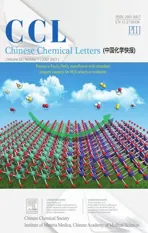Rapid detection of pesticide residues in Chinese herbal medicines by molecularly imprinted membrane electrospray ionization mass spectrometry
2021-10-12ChunmeiWuTinyiLiDongjuLiShnshnJiJinmeiHungHiminLeiMeiZhng
Chunmei Wu,Tinyi Li,Dongju Li,Shnshn Ji,Jinmei Hung,Himin Lei,Mei Zhng,*
a School of Chinese Materia Medica, Beijing University of Chinese Medicine, Beijing 102488, China
b National Institute for Communicable Disease Control and Prevention, Chinese Center for Disease Control and Prevention, Beijing 102206, China
c Experimental Teaching Center, School of Basic Medical Sciences, Fudan University, Shanghai 200032, China
1 These authors contributed equally to this work.
ABSTRACT Chinese herbal medicines(CHMs)play an increasingly important role in the field of medicine and affects public health in the world.Although more and more strict has been employed to ensure the quality and safety of CHMs,pesticide residues in CHMs remain a serious issue and are the bottleneck for the global development of CHMs.In this work, we applied molecularly imprinted membrane electrospray mass spectrometry (MIM-ESI MS) for rapid detecting 4 classes of pesticide residues in CHMs, including organophosphorus (OPP), carbamates, pyrethroids and neonicotinoids in CHMs.Compared with our previous ambient ionization method MESI, MIM-ESI is capable of achieving a ~50-fold increase in the detection limit of conventional analytical methods owing to the specificity recognition and unique enrichment of MIM.The optimal experimental conditions were determined,and the method was further validated for its sensitivity and specificity.Our data showed that MIM-ESI MS is applicable for the direct quantitation of pesticide residues in CHMs.This detection technology may help to ensure the quality of CHMs in the future.
Keywords:Pesticides residue Chinese herbal medicines (CHMs)Rapid detection Molecularly imprinted membrane Ambient ionization Mass spectrometry
Chinese herbal medicines(CHMs)have been used in China for thousands of years, with various therapeutic effects.However,pollution by heavy metals, widespread pesticide residues,excessive mycotoxin content, and sulfur dioxide residues are increasingly a threat to human health.Furthermore, the contamination has limited CHMs to be more widely accepted on the international stage.In recent years,China has undertaken a series of steps to promote the development of Chinese medicine and emphasizes the importance of quality of CHMs including more strict standards of pesticide residues in Chinese herbal medicine.Large scale farming of CHMs has become an inevitable trend in many parts of China.The farming and processing of medicinal plants are susceptible to pests and natural diseases.Chemical pesticides have been used to effectively prevent and control plant diseases and to eliminate pests.Pesticides used can be divided into four major families, including organochlorine(OCP),organophosphorus(OPP),carbamates and pyrethroids[1].OCP is highly poisonous and hard to be degraded naturally,it has been banned in most countries for three decades.OCP has been replaced by OPP with low toxicity and shorter half-life in nature.In recent years, carbamate and pyrethroid have been used in CHMs[2].The wide use of pesticide has led to increased pesticide residues in Chinese herbal materials.It is thought that pesticide residues may pose a bottleneck for global adaptation of CHMs.
The methods available to determine pesticide residues are GC[3–5], HPLC [6,7],GC–MS[8–10],HPLC-MS[11,12],CE [13,14] and ELISA[15,16].Chromatography offers fast separation and efficient detection and becomes a popular technique for the detection of pesticide residues.Most of the current protocols require sample treatment such as liquid-liquid extraction and off-line SPE (solid phase extraction).Thus, they are time-consuming and expensive.Immunoassay delivers specific, sensitive and rapid detection methods.However,few antibodies against pesticides are available due to their small molecular weights.Therefore,there is an urgent need for a fast,sensitive,specific and affordable method to detect pesticide residues.
The recent development of ambient ionization technologies,direct sample analysis provides an open environment allowed for MS analysis.Direct analysis in real-time(DART)[17,18],desorption electrospray ionization (DESI) [19], paper spray ionization (PS)[20,21],etc.[22–27],facilitated direct analysis of complex samples without or little sample pretreatment.
We previously developed the molecularly imprinted membrane electrospray ionization (MIM-ESI) technique [28], in which MIM was applied for target enrichment.MIM-ESI reduces matrixes in CHMs sample with specific adsorption and enrichment of MIM[29–31].Therefore, MIM-ESI MS could potentially achieve direct detection with high sensitivity while minimizing sample pretreatment steps.In this study,we developed a rapid analytical method to detect four main classes of pesticides in CHMs using MIM-ESI MS.This method can potentially be coupled with portable MS and used on-site in the field.
Polyvinylidene difluoride (PVDF) membrane was purchased from Agela Technologies (Tianjin, China;Φ 25 mm, 0.45 μm pore size); Tolclofos-methyl (TCFM), chlorpyrifos (CPF), carbofuran(CBF), fenobucarb (FBC), theta-cypermethrin (CYP), deltamethrin(DEL), thiacloprid (THI), imidacloprid (IMI), 2,2′-azoisobutyronitrile(AIBN),ethylene glycol dimethacrylate(EGDMA),methacrylic acid (MAA), styrene (ST), acrylamide (AM), acrylic acid (AA), and potassium peroxydisulfate (KPS) were purchased from Sigma-Aldrich (MO, USA ); HPLC grade methanol (MeOH), acetone,acetonitrile (ACN), acetic acid (HOAc) and formic acid (FA) were purchased from Fisher Scientific (NJ, USA); pure water was purchased from Wahaha (Hangzhou, China).Panax notoginseng,Angelica sinensis and Codonopsis pilosula were purchased from a local Chinese medical materials market (Beijing, China).
The MIM was prepared according to the published procedure[32].Briefly, the membrane was activated by being soaked in 3%NaOH(aq.)at 60°C for 12 h.The membrane was washed in water,and then it was soaked in a solution containing 10%AA and 1%KPS at 70°C for 5 h.Next,the activated membrane was dried after being soaked sequentially in pure water for 1 h, ACN 30 min, and then 0.15 mol/L AIBN ACN solution for 20 min.
In a typical procedure, the corresponding template and functional monomer were dissolved by ultrasound in the porogenic solvent and kept at room temperature for 1-2 h to achieve complete prepolymerization.Then,cross-linker(EGDMA)and initiator (AIBN) were dissolved in the prepolymer solution,and then the activated membrane was soaked in the above solution immediately and deoxygenized by an ultrasonic bath.Next,the membrane was heated under nitrogen protection at the corresponding temperature and time in an oven.When the MIM was completed, template molecules were removed by MeOH:HOAc (9:1 v/v).Finally, the MIM was rinsed by pure water to neutral.MIM was typically prepared before and kept in a desiccator and ready for use.All detailed conditions for different classes of pesticides were summarized in Table S1 (Supporting information).
To prepare practical samples, 100 mg the herbal material samples were smashed and extracted with 1.5 mL acetonitrile in an ultrasonic bath for 5 min.The extracts were centrifuged at 12,000 g for 5 min, and CPF, FBC, DEL and IMI were directly spiked into supernatants, respectively.The MIM was soaked in the practical samples in 2 mL EP tube and shaken for 20 min at room temperature.The MIM was rinsed by pure water and dried out,and then the MIM was ready to use in the MIM-ESI MS experiments.The practical samples were analyzed by MIM-ESI MS and MESI-MS, respectively.
Experiments of MIM-ESI MS analysis were carried out by reported method[28],and experimental conditions of applied HV,adsorption time, extraction solution and elution solution were optimized.The detailed information of mass spectrometry experiments were given in the Supplementary material,including MIM-ESI MS, MESI-MS, nanoESI-MS analysis.
To facilitate the detection of pesticide residues in Chinese herbal medicines(CHMs),we developed a quantitative method for rapid detection of pesticide residues in CHMs using MIM-ESI MS.MIM-ESI setup and workflow were shown in Fig.1.In each class of pesticides, one molecule was used to be the target analyte as an example.To minimize the inaccuracy in quantitation analysis by template residues, the template molecule was choosing that similar structures to analytes in different molecule weights(Table S1 in Supporting information).We have demonstrated that most of the matrix can be removed after washing step [28].
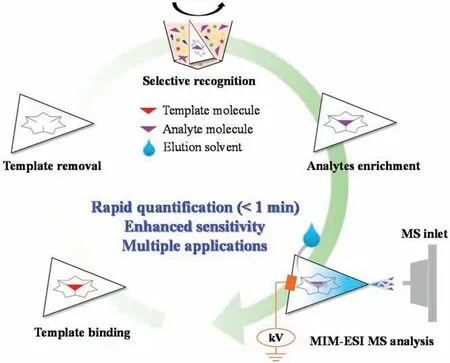
Fig.1.MIM-ESI MS setup and the analysis workflow.
Rapid quantitative detection for pesticide residues in CHMs suffers from a low concentration of analytes, complex sample pretreatment and matrices effects.MIM-ESI MS can address these issues owing to its capability of specific recognition and enrichment by MIM.MIM-ESI has better performance than the conventional nanoESI or other ambient ionization methods, such as our previously developed MESI.Fig.2 showed a comparative experiment using different methods to analyze the target analyte CPF.TCFM was chosen as a template molecule and 8 μL of MeOH with 0.1%FA was used as the elution solvent.Specifically,as shown in Fig.2a,LOQ of 50 ng/mL comparing to nanoESI and MESI,MIMESI had a lower LOQ of 1 ng/mL.MS2spectra at the LOQs in each case were also plotted in Figs.2b-d, and the fragmentation pathway of CPF was described in Fig.2e.Compared with the conventional nanoESI and MESI, MIM-ESI shows a wider linear range,the lower limit of quantitation(LOQ),higher sensitivity and better selectivity.
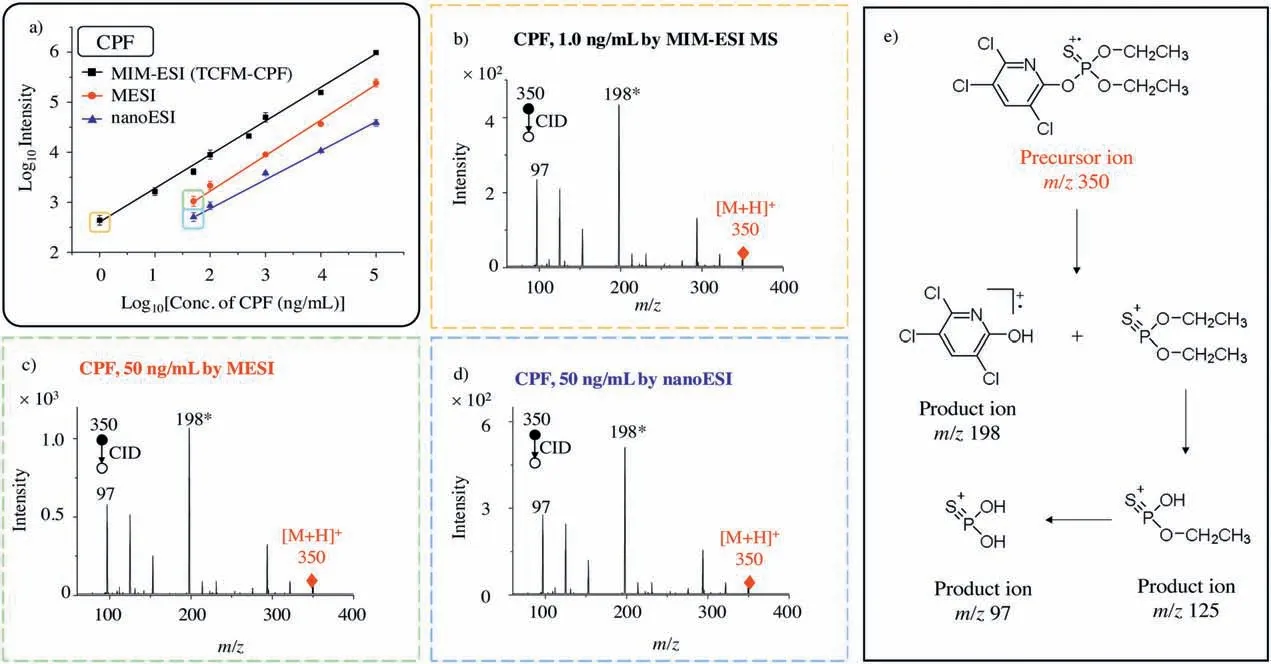
Fig.2.Linear ranges and MS2 spectra of CPF using MIM-ESI MS and nanoESI-MS:(a)Standard curves of CPF detected by MIM-ESI MS and nanoESI-MS;(b,c)MS2 spectra in LOQ of CPF detected by MIM-ESI MS and nanoESI-MS; (d) fragmentation pathway of CPF.
IMI(10 ng/mL)was used as a model sample in the optimization experiment.According to the intensity of quantitative fragment ion, applied HV, adsorption time, extraction solvent and elution solvent were optimized.The results for optimization of experimental conditions were summarized in Fig.S1 (Supporting information).It can be seen in Fig.S1a, IMI in ACN could achieve the highest intensity when the applied HV was+2.5 kV.Completely adsorption and elution are the keys to quantitative analysis of target analysis.It is necessary to investigate adsorption time and elution solvent.As shown in Figs.S1b and c, the best adsorption time was 20 min and MeOH with 0.1% FA as elution solvent.
The simple extraction process of CHMs, including powdering,ultrasonic extraction and centrifugation, the extract without purification was used as a real sample to analyze pesticide residues by MIM-ESI MS.The result is shown in Fig.S1d that ACN and acetone had a corresponding extraction effect.High concentration of pigment was extracted by acetone which was not conducive to the following analysis.Therefore,ACN was chosen as the elution solvent in MIM-ESI analysis.In addition, specific recognition function was demonstrated by the comparative experiments using MIM versus nonimprinted membrane (NIM)(Fig.S1e).
As an ambient ionization technique, MIM-ESI MS is able to directly quantify pesticide residues in CHMs.The performance of MIM-ESI MS for quantification of pesticide residues in CHMs real samples have been investigated.Four pesticides in different classes(CPF,FBC,DEL and IMI)were directly spiked into CHMs materials,respectively.Extracts of CHMs samples without spiking pesticides were used as blank samples.Four similar molecules (TCFM, CBF,CYP and THI) were chosen as templates for preparing the MIM.
All CHMs samples were analyzed using MIM-ESI MS without any purification process,and the results were plotted in Fig.3.Pairs of precursor/product ions were used for quantitation, and all results including linear range,R2,LOD and LOQ were summarized in Table 1.The methodology of MIM-ESI MS analysis was validated,including precision, accuracy and recovery rates.Quantitative control (QC) samples of four different pesticides at low/medium/high concentration were added to three CHMs(Panax notoginseng,Angelica sinensis and Codonopsis pilosula)for methodology validation.The extract without spiking pesticide residues was used for negative samples, and each sample was detected for 5 times in 3 days as parallel detections.The results were summarized in Table 2.It has been demonstrated that the developed MIM-ESI MS method is able to determine different classes of pesticide residues accurately and precisely in simulated CHMs samples.

Table 1 Calibration curves of four kinds of pesticides using MIM-ESI MS ( n=5).
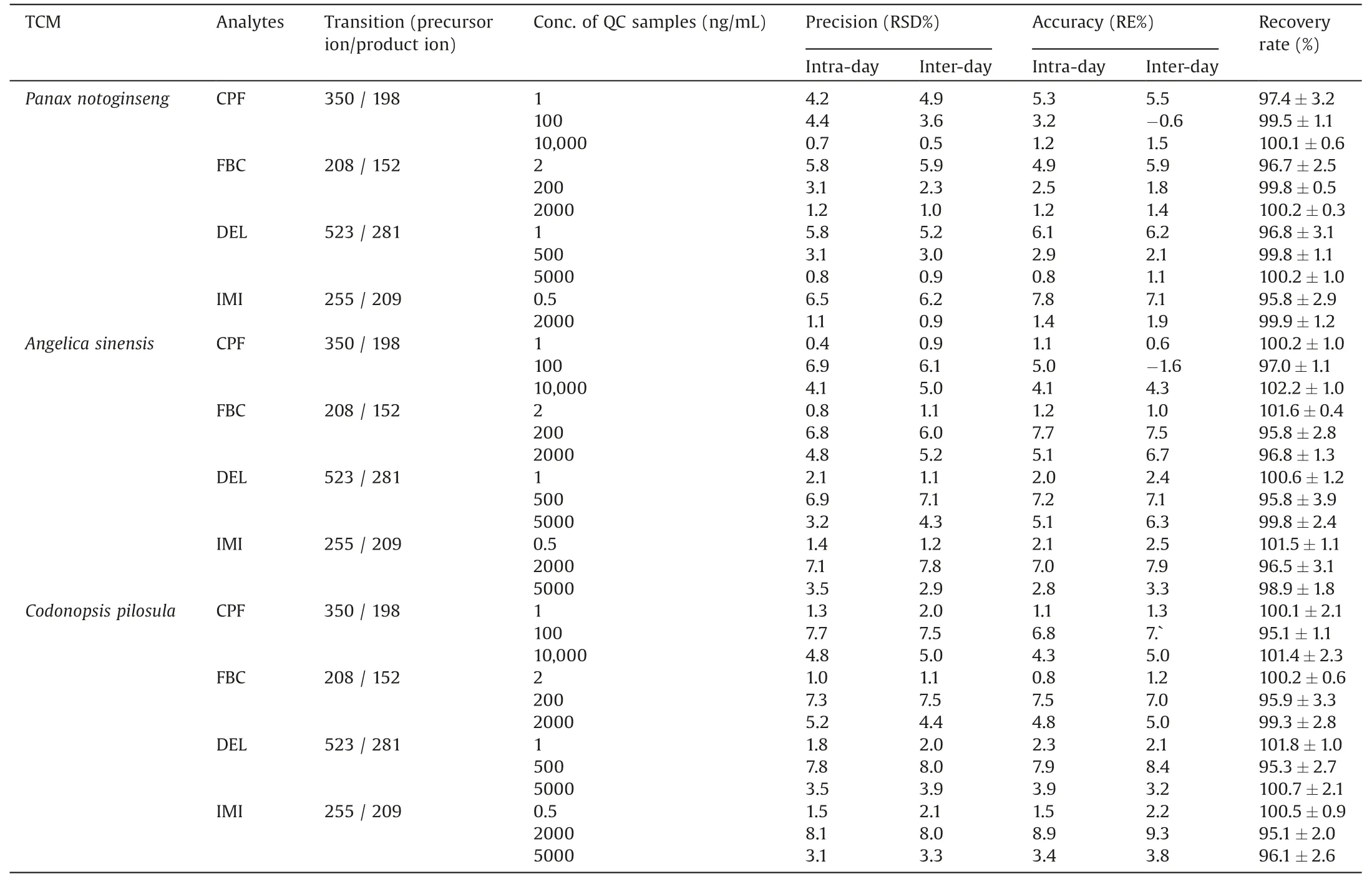
Table 2 Precision, accuracy and recovery rates of four classes of pesticides in TCM using MIM-ESI MS (n=5, 3 days).
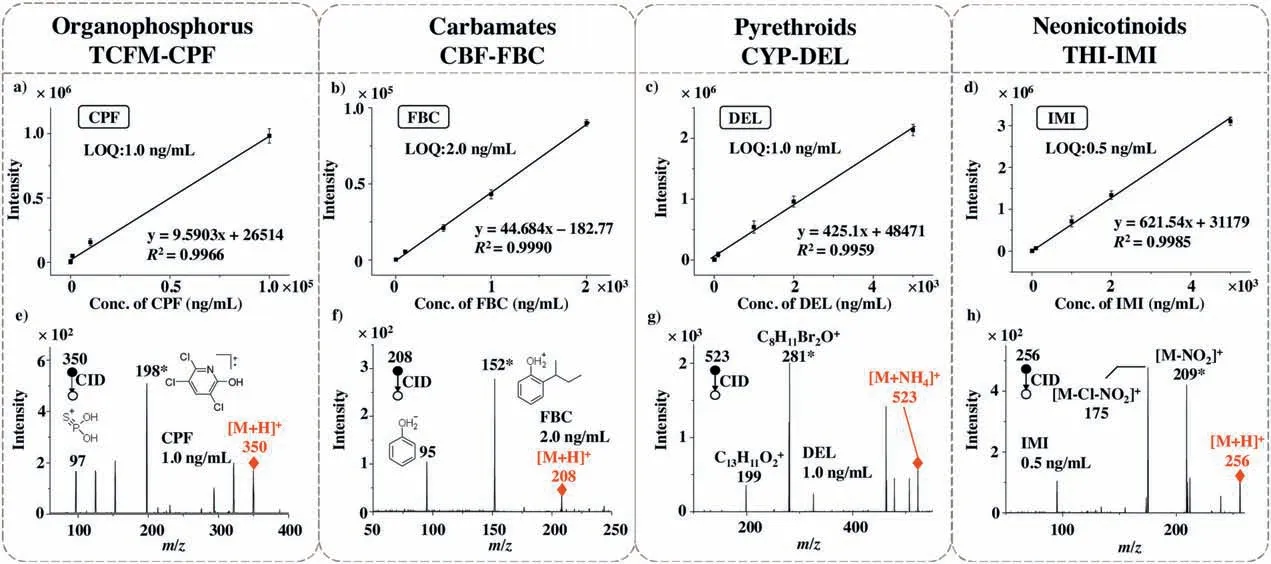
Fig.3.Four different classes of pesticides residues in herbal samples detected by MIM-ESI MS/MS:(a-d)Calibration curves of different pesticides residues;(e-h)MS2 spectra of different pesticides residues in their LOQs situation.
In summary,MIM-ESI MS method was applied to detect a trace amount of pesticide residues in CHMs.MIM-ESI MS has satisfactory performances for direct rapid quantification of different classes of pesticide residues in CHMs samples.The novel assay has high sensitivity and specificity, and its accuracy,precision and recovery rate had been validated for analyzing herbal samples.
Declaration of competing interest
The authors declare that they have no known competing financial interests or personal relationships that could have appeared to influence the work reported in this paper.
Acknowledgments
This research was supported by the National Natural Science Foundation of China(No. 82072247)to MZ and the Young Scholar Project of Beijing University of Chinese Medicine ( Nos.2019-JYBJS-017 and 2021-JYB-XJSJJ001) to SJ and MZ.
Appendix A.Supplementary data
Supplementary material related to this article can be found,in the online version, at doi:https://doi.org/10.1016/j.cclet.2020.11.060.
杂志排行
Chinese Chemical Letters的其它文章
- A millimeter-sized negatively charged polymer embedded with molybdenum disulfide nanosheets for efficient removal of Pb(II) from aqueous solution
- Hyperterpenoids A and B: Two pairs of unprecedented 6/6/4/6/6 polycyclic cyclobutane meroterpenoids with potent neuroprotective and anti-inflammatory activities from Hypericum beanii
- Ammonia leaching mechanism and kinetics of LiCoO2 material from spent lithium-ion batteries
- Design, synthesis and biological evaluation of pyridyl substituted benzoxazepinones as potent and selective inhibitors of aldosterone synthase
- A DNA G-quadruplex converts SOD1 into fibrillar aggregates
- Built-in piezoelectric field improved photocatalytic performance of nanoflower-like Bi2WO6 using low-power white LEDs
